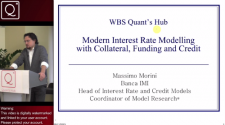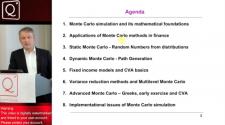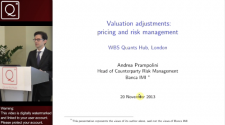Workshop view
Back to Shop
Monte Carlo Simulation in Finance (Part 1)
Monte Carlo Simulation in Finance: Models, Algorithms and Practice with Application to Derivatives Pricing, Risk Measures and CVA (Part 1)
Presenter: Jörg Kienitz: Head of Quantitative Analysis, Treasury, Deutsche Postbank
Course Running Time: 6 Hours 30 Minutes
Session 1: (Running Time: 08:08)
Session 2 (Running Time: 1:15:00)
Session 2a: (Running Time: 1:08:00)
Session 3 (Running Time: 1:36:16)
Session 4: (Running Time: 1:31:57)
Session 5 (Running Time: 1:08:52)
Summary:
The goal of this two day seminar is to provide a detailed overview, offering insights into the latest techniques of modeling uncertainty in financial markets and demonstrating computational methods to tackle the industry applied models. We show the applicability of Monte Carlo simulation to derivatives pricing, risk measurements or CVA calculation.
We explain how the basic method is set up and we discuss the main ingredients. Finally, we discuss methods for improving and speeding up the method as well as recent techniques for calculating Greeks.
Each single topic is illustrated using Matlab code (No Laptops are needed for this event, however delegates will be given example sheets) .
The seminar is an ideal way to get a detailed overview of Monte Carlo methods and how to apply such techniques to problems arising in finance.
Main Topics:
This seminar discusses the application of Monte Carlo simulation to financial problems. Problems include scenario generation, risk measures, derivatives pricing or CVA calculation. The bullet points are:
• Probability Theory and Stochastic Processes
• One and multifactor models
• General purpose and special sampling schemes for e.g. Heston or SABR models
• Static and dynamic Monte Carlo Methods
• Risk Measures via scenario generation
• Derivatives pricing and hedging strategies
• Interest rate simulation and CVA
• Calculating sensitivities (‘Greeks’) and early exercise rights
• Implementing Monte Carlo methods
Methods:
• Presentation (slides)
• Illustration using computer examples
Prerequisites:
To participate in this course, you need to have a basic background in stochastic modelling but all the concepts and models are introduced and discussed in detail.
Day 1 Topics:
Mathematical Basics
- Foundations of Probability
- How does Monte Carlo Work?
- Distributions
- Basic Distributions in Finance
- Stochastic Processes
- Diffusion Processes
- Jump-Diffusion Processes
- Jump Processes
Applications of the Monte Carlo Method
- Option Pricing
- Evaluating Hedge Strategies
- Scenario Generation and Risk Measures
Static Monte Carlo Simulation
- Sampling from the Uniform Distribution
- Random Number Generators
- Good ones and bad ones
- Sampling Techniques
- Inverse Method
- Ratio of Uniforms
- Sampling from the Normal and other Distributions
Dynamic Monte Carlo Simulation
- Path Generation Methods
- (Log) Euler-Scheme
- Predictor Corrector
- Bridge Sampling
- Exact Sampling
- Sampling from Jump Diffusion Processes
- SGS Sampling
- FGS Sampling
- Sampling from Pure Jump Processes
- Variance Gamma, NIG
- Stochastic Volatility Lévy Models
Implementation Issues (from Algorithms to Code I)
- Ingredients for a successful implementation of Monte Carlo algorithms
- Object Oriented Design I
Academic level
Topic
CVAPublished date
7 March 2014Price
£199.00Related workshops

Massimo Morini
Interest Rate Modelling: Modern Interest Rate Modelling with Collateral, Funding and Credit (Part 2)
4 March 2014
Alexander Sokol
XVA: Long Term Portfolio Simulation for CVA, Funding, Limits, and Capital
7 March 2014





